Exhibit A: FromCuteOverload

Exhibit B: DowntownMinneapolis
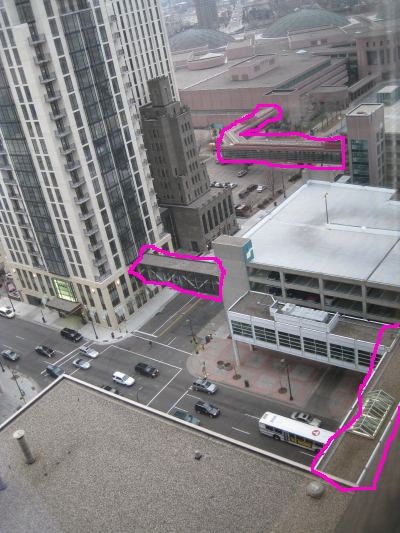
No, really — any questions? 😉
Well, after about 4 weeks of meetings and travel, I have a new pair of
socks. I guess I must not knit very quickly — to take so many
weeks to produce a pair. But, I’m on to the next pair already.
These are done in White
Birch Fiber Arts sock yarn, knit toe-up with Cat Bordhi’s
Riverbed sole increases and “Gothic Lattice” pattern from Barbara
Walker’s “3rd Treasury” for the ankle patterning.
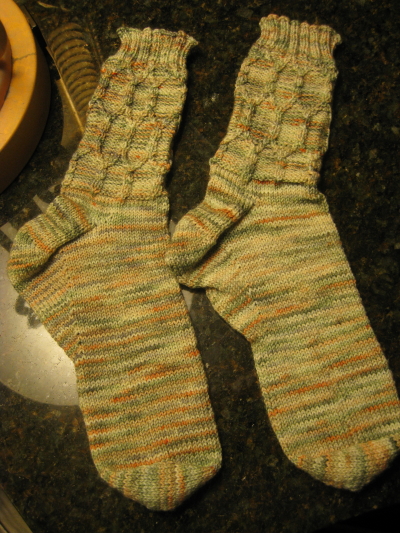
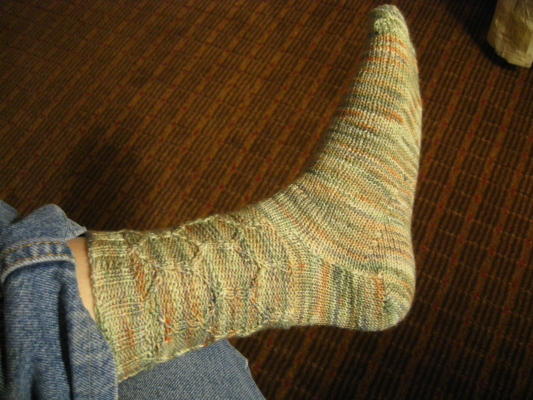
More detail, and closer to true colours:
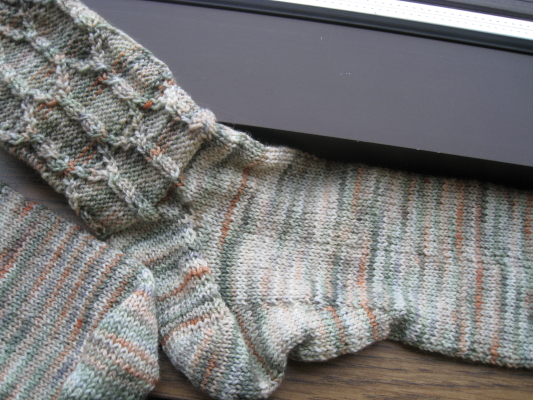
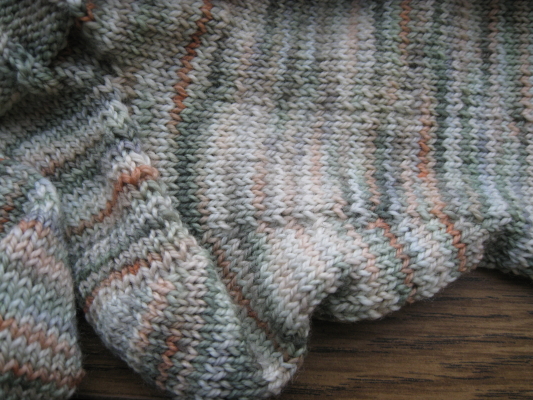
I
mentioned that this burst of blogging is somewhat inspired by the
(writer’s block busting) activity of NaNoWriMo.
It turns out that I am hardly alone in this aspiration. Someone
else has coined the NaBloPoMo
term for national blog posting month — blogging every day this
month. That certainly captures the spirit of what I’ve been
trying this month, although I am resisting any urge to sign up.
Stubborn individualism, I guess.
There is also a NaKniSweMo
— national sweater knitting month — focused on knitting a 50,000
stitch sweater (to match the 50,000 word novels of
NaNoWriMo). I’m really not doing that — if
nothing else, because I don’t take sweater projects on travel.
However, I did the math: I figure my sock project is running at
10,000 stitches per sock. I am about to finish my first November
sock (the second of a pair — expect pictures!). I
might put another 10,000 stitches out, depending on what happens with
personal travel next week. Nowhere near the 50,000 stitch mark.
I guess, no matter whether you slice it in words ore stitches, 50k is a
lot. Even for knitting, which is essentially OCD with a
productive output.
The other day, with some new laceweight yarn in hand, I was browsing
for patterns for shrugs. (I could make a lace stole, but I think
it would be nice to have a colourful shrug to wear over a sleeveless
dress, as an alternative to having to balance drapey fabric all
evening). More specifically, I was browsing through the
patterns for shrugs listed on Ravelry.
To make a long story short, I came across the Rowan pattern Carolina, from their issue
39. From the available pictures, it really stood out as being
the most lacey, interesting, lightweight shrug. Currently, 22
people have projects started (or completed) for this pattern, and you
can review the pictures posted in Ravelry. A couple of them are here
and here
in Flickr. I thought it was interesting enough that I actually
tracked down and ordered the relevant issue of Rowan.
The thing that amazed me was that, flipping through the magazine, the
official pictures of the pattern are quite dull. Clearly, the
photographer and/or the magazine layout person was not enamoured of
this project, and simply did not show it up to its full
advantage. I guess they didn’t “feel the love”!
So — their magazine did not sell itself (or the pattern) to me.
Rather, Ravelry’s collective database of projects and pattern
information did. It’s another example that filtering everything
through one small perspective (that of the magazine layout process)
does not have nearly the reach that providing open access to multiple
perspectives and sharing opportunities can.
I never want to be limited to the perspective of a single provider.
Comments Off on The Power of a Collective
Posted in All, Knitting, Net Working
I recently got one of my suitcases back from the authorized repair shop
— it cost $50 to have a wheel replaced and a zipper pull-tab
re-installed. Although the luggage was hardly cheap,
that’s still a significant fraction of the original capital cost, and
it makes me wonder whether the original purchase was good
value. If the luggage is going to break anyway, why buy
expensive stuff?
Arriving here last night, I found my other suitcase had only one
functioning handle — the end of the other handle had been pulled off.
I do feel thankful — as my friends’ luggage failed to appear, and here
was my luggage, even absent the big airline routing label that had
slipped off the detached handle.
I should be able to reattach the handle — having cut through the inner
lining of the suitcase to access the screws. However, the head on
the screw is neither Robertson nor Phillips nor flathead — some other,
unusual variation. If I had my trusty screw
driver bit set from RenoDepot, I could
get these screws back in and have a handled suitcase to ship
home.
So — what is a truly robust luggage system? And/or, why does
Samsonite insist on requiring obscure tools and know-how to mend their
suitcases within trip?
Some words of wisdom you might have occasion to take advantage
of… if you are hanging around in the home turf of these guys
these are not the proper
footwear
unless you really like to share your shoes with lots of this
If the depth has been lost in the digital photograph, let me assure you
there’s a good half cup (125mL) of sand from that shoe.
It turns out that the sand is really fine — finer than the mesh of the
running shoes — so it seeps right in. After a few moments, your
brand new, expensive running shoes feel like they are lined with
cement, and your feet are feeling like they ought to be moving out.
I recently installed NoScript as an
add-on to Firefox. I observed the Firefox application randomly
running my CPU up to 80% usage and holding, and I was pointed at
scripts as a likely culprit. Indeed — as soon as I started
blocking web page scripts, my Firefox process CPU consumption dropped
below 5%.
Of course, this also means that I’ve become much more aware of the
scripts that are commonly embedded in any number of my usual website
haunts. One name that keeps popping up —
“google-analytics.com”. A lot of sites use the convenient
Google tool to capture and track information about their
viewers. Hmmm…
Now, I’m a fan of reviewing web statistics to understand what’s being
done with my site. As you might note, from the sidebar, I use Firestats to see what’s what with this
blog. I don’t get (and I don’t want) much information — I see
information about the number of page views and visitors in the past 24
hours; browser type/computing platform; and, where available,
referring page. It’s good to know what kinds of
things people are looking for and how they get lead to my pages.
And, that’s where the information stops.
If I used Google Analytics, I would be shipping all that information to
Google, where I would presumably have a dashboard with much more
complex results (as they analyze the data from my site, compare it
against data from other sites, and draw inferences).
But the difference in the model is kind of interesting: instead
of you simply leaving a bit of a trace of yourself on my doorstep (with
Firestats), we’d be telling Google more about your browsing habits, and
my site popularity. Great for Google — but I’m not so sure I’m
comfortable sharing that kind of information with a 3rd party.
So, for now, I’ll leave NoScripts running and not let my web footprints
at other sites track through the Google databases.
Comments Off on What a Tangled Web We Weave…
Posted in All, Net Working
As I was writing the
entry about my current sweater design effort, I surprised myself by
reaching the tentative conclusion that I should rip the whole thing
back (frog it) and do something more compelling with the lovely
yarn. I really had not thought about that before sitting
down and writing out the text. It was an interesting revelation
that had to be considered.
I reflected on it for a couple of days. And, I reviewed my very
old blog entry (see here, and scroll down to “Knitting Broccoli”) about
a previous effort that I slogged through and eventually had to
frog. I compared the projects.
In the end — I think I will not
frog the current design effort, at least not yet. While I am not
wild about the colour combinations, I do feel I am still committed
enough to the project that I am checking important things like length
and other measurements. I am not at all convinced that there is a different pattern of these
same colours that would really cause me to whip through a sweater
project at this time. I’ve been travelling — travel
projects make better progress. Quelle surprise. I do still
believe I will be happy to wear the resulting sweater if I just finish
it, AND I believe that I am making progress (albeit slow) towards
completing it reasonably. That’s a really long-winded way of
working my way to the point that I
think my biggest problem is that I am not spending much time on large
knitting projects at home, and ANYTHING is going to take a long time to
complete.
Somehow, that didn’t stop me from buying 6 skeins (a sweater’s worth)
of Araucania
Azapa (colourway Cornflower) today — I’m in meetings near Knit
Happens, and I Happened to wander in, let my hand touch a skein and
that was just that 🙂
There were multiple announcements today of home mortgage bailouts in
the US – from
Citibank to its customers, as well as US Federal bailout plans via
Freddie Mac and Fannie Mae.
The Citibank plan offers the possibility of reviewing the principal of
the loan as one possible parameter to adjust in aiming to bring the
mortgage payments of a principal residence under 40% of monthly
income. Wait a minute — isn’t that retroactively changing the
price of the house you bought? How is that fair to the
neighbours? Or to those who purchased more modest
homes? Well, the answers there are:
As a flipside of the fairness coin — those who are not concerned about
whether or not it is “fair” are concerned with whether or not the
availability of bailouts for some will cause an escalated demand from
those who have been struggling but surviving: why should they
try, if they can get a bailout?
Also, it’s not entirely clear that banks will simply slash the value of
the principal. Other
banks are apparently considering different things:
The federal plans are already coming under criticism because they will not adjust principal. Well, this is taxpayer money — why should I pay my taxes to bail out someone who bought a house that I would only dream of (and, unlike them, had the good sense to realize I could not afford?) But, “experts” are concerned that people will walk away from mortgaged homes if their mortgaged value is greater than the current value of the home. In other countries, people doing that would be crushed by the inevitable ensuing personal bankruptcy; in the US, that’s not currently a very difficult reputation to shed.
The math here is really not simple, as the pros and cons have to be
weighed to consider
1/ The current situation was caused,
in a large part, by people making bad, overreaching choices in an
atmosphere that was devoid of expectation of (negative) consequences.
Being able to walk away from some or all of a mortgage does nothing to
address that.
2/ The current situation goes well
beyond the mortgage market. We haven’t even begun to see
the extent of the credit crisis, but we need to be aware that it is not
limited to the US (there are global collapses).
3/ The “righting” of markets is
taking down giants — such as DHL and General
Motors. If and as these types of companies fail, the
repercussions reach far and wide. The American
auto industry has a broad reach:
The impact of not propping up mortgages, GM, etc, even if it
means bad decisions get rewarded, may be far too great to ignore.
So, the questions are — is it possible to bail out “enough”, and how
do we ever get to a situation of adequate responsibility for individual
choices so that we can stop the madness of the spiral of bad decisions
that got us here?
Have we even begun to see the bottom of this hole?